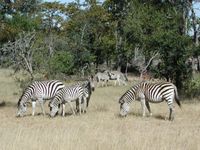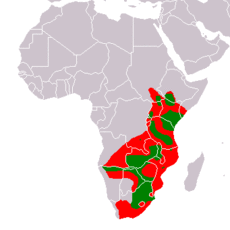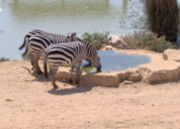Plains Zebra
2007 Schools Wikipedia Selection. Related subjects: Mammals
| iPlains Zebra | ||||||||||||||||
|---|---|---|---|---|---|---|---|---|---|---|---|---|---|---|---|---|
 |
||||||||||||||||
|
|
||||||||||||||||
 Least Concern (LC) |
||||||||||||||||
| Scientific classification | ||||||||||||||||
|
||||||||||||||||
|
|
||||||||||||||||
| Equus quagga Boddaert, 1785 |
||||||||||||||||
|
|
||||||||||||||||
|
E. q. quagga |
The Plains Zebra, or Common Zebra, or Burchell's Zebra (Equus quagga, formerly Equus burchelli) is the most common and geographically widespread form of zebra, once being found on plains and grasslands from the south of Ethiopia right through east Africa as far south as Angola and eastern South Africa. Plains Zebras are much less numerous than they once were, because of human activities such as hunting them for their meat and hides, as well as encroachment on much of their former habitat, but they remain common in game reserves.
Plains Zebras are mid-sized and thick bodied with relatively short legs. Adults of both sexes stand about 1.4 metres high at the shoulder, are approximately 2.3 metres long, and weigh about 230 kg. Like all zebras, they are boldly striped in black and white and no two individuals look exactly alike. All have vertical stripes on the forepart of the body, which tend towards the horizontal on the hindquarters. The northern species have narrower and more defined striping; southern populations have varied but lesser amounts of striping on the underparts, the legs and the hindquarters. The first subspecies to be described, the Quagga which is now extinct, had plain brown hindquarters. (Technically, because the Quagga was described first as E. quagga, the proper zoological name for the most common form of the Plains Zebra is E. quagga burchelli.)
Plains Zebras are highly social and usually form small family groups consisting of a single stallion, one, two, or several mares, and their recent offspring. Groups are permanent, and group size tends to vary with habitat: in poor country the groups are small. From time to time, Plains Zebra families group together into large herds, both with one another and with other grazing species, notably Blue Wildebeests.
Unlike many of the large ungulates of Africa, Plains Zebras prefer but do not require short grass to graze on. In consequence, they range more widely than many other species, even into woodland, and they are often the first grazing species to appear in a well-vegetated area. Only after zebras have cropped and trampled the long grasses do wildebeests and gazelles move in. Nevertheless, for protection from predators, Plains Zebras retreat into open areas with good visibility at night time, and take it in turns standing watch. They eat a wide range of different grasses, preferring young, fresh growth where available, and also browse on leaves and shoots from time to time.
Subspecies
In 2004, C.P. Groves and C.H, Bell have done investigations on the taxonomy of the zebras genus Equus, subgenus Hippotigris. They published their research in Mammalian Biology. They revised the subspecies of the plain zebra Equus quagga. Six subspecies are recognizable. The completely maneless Somali population may represent a seventh subspecies: Equus quagga isabella (Ziccardi, 1958). This subspecies may be valid, but at present there is no evidence that it is.
- Quagga, Equus quagga quagga Boddaert, 1785 †
- Burchell's Zebra, Equus quagga burchellii Gray, 1824
- Grant's Zebra, Equus quagga boehmi Matschie, 1892
- Selous' zebra, Equus quagga borensis Lönnberg, 1921
- Chapman's Zebra, Equus quagga chapmani Layard, 1865
- Crawshay's Zebra, Equus quagga crawshayi De Winton, 1896

